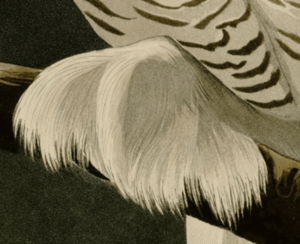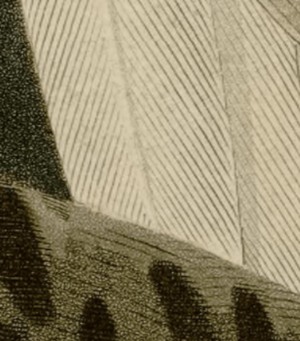Snowy Owl (Audubon) facts for kids
Quick facts for kids Snowy Owl |
|
|---|---|

John James Audubon's etching
|
|
| Artist | John James Audubon |
| Year | 1882 |
| Type | Engraving |
| Location | In various archives, museums and collections around the world. |
| Owner | University of Pittsburgh |
The Snowy Owl is a famous picture created by John James Audubon. He was a naturalist, which means he studied nature, and also a talented painter. This artwork is an engraving, a type of print made by carving a design into a surface. It's one of the first detailed pictures of a snowy owl and is part of his huge book called The Birds of America.
Audubon first published this picture around 1831 as part of a series. Like other pictures in The Birds of America, the Snowy Owl is a hand-coloured engraving. It was made from copper plates that had designs carved into them. Each print measures about 39 by 26 inches (about 99 by 66 cm).
The Birds of America also includes pictures of six birds that are now extinct, meaning they no longer exist. Art experts say that Audubon's work was very high quality and beautifully printed.
Audubon's assistants, including Joseph Mason, drew the plant backgrounds in this engraving. However, they were not given credit in the book. Audubon created the artwork by first shooting the owls. Then, he would carefully pose them and paint them.
After painting, he guided the creation of the printing plate based on his artwork. Audubon also wrote details about the bird itself in his book Ornithological Biographies. The Snowy Owl engraving was made by Robert Havell. The first prints were made on special paper with a watermark from J. Whatman.
The border of the picture says "Snowy Owl (No. 25, Plate CXXI)" and "Strix Nyctea". At the bottom left, it says "Drawn from Nature by J. J. Audubon F.R.S.F.L.S." On the bottom right, it reads "Engraved, Printed & Coloured by R.R.Havell, London".
Contents
How the Artwork Was Made
Audubon usually used oil colours for his art. But for the Snowy Owl, he used watercolours and pastel crayons. Sometimes he also used pencil, charcoal, chalk, gouache, and pen and ink. His very first drawing of a snowy owl was done in pastels in 1809.
The Snowy Owl was part of the first edition of The Birds of America. This edition is sometimes called the Havell Edition, named after its printer. It's also known as the "Double Elephant Folio" because of its huge size. The paper used was handmade and measured 39.5 inches tall by 28.5 inches wide (about 100.3 × 72.4 cm).
The main way these pictures were printed was through copperplate etching. This means designs were carved into copper plates. Engraving and aquatint (another printing method) were also used. After printing, many colourists worked together to add colours. They worked like an assembly line, with over fifty people hired for the job. Audubon sold these Snowy Owl engravings to rich supporters as part of his big book.
Audubon wrote about the snowy owl in his Ornithological Biographies. He wrote this book with William MacGillivray, a Scottish naturalist who studied birds. As a naturalist, Audubon would often examine what was inside the stomachs of owls to learn about their diet.
What Experts Say About the Art
Art experts have described the Snowy Owl picture in a special way. They say the owls in the image look directly into the eyes of the person viewing the artwork. The owls stand out against a dark background, where you can see a winter storm starting.
Audubon showed the birds sitting on a tree branch. However, snowy owls usually live in the tundra, a treeless area. So, they don't often perch on trees. The female owl in the picture is shown as being larger than the male, which is true in real life.
Where You Can See It
The Snowy Owl engraving has been shown by itself and as part of The Birds of America exhibitions at these places:
- University of Michigan, Ann Arbor
- Louisiana State University
- University of Pittsburgh
- Teylers Museum
- New-York Historical Society
Where It Is Kept
Copies of the Snowy Owl engraving are kept in these collections and archives:
- The Darlington Collection
- Meisei University
- Trinity College



